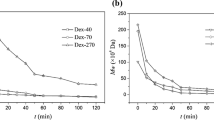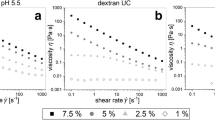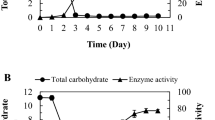Abstract
Dextran synthesis has been studied since the Second World War, when it was used as blood plasma expander. This polysaccharide composed of glucose units is linked by an α-1,6-glucosidic bond. Dextransucrase is a bacterial extra cellular enzyme, which promotes the dextran synthesis from sucrose. When, besides sucrose, another substrate (acceptor) is also present in the reactor, oligosaccharides are produced and part of the glucosyl moieties from glucose is consumed to form these acceptor products, decreasing the dextran yield. Although dextran enzymatic synthesis has been extensively studied, there are few published studies regarding its molecular weight distribution. In this work, the effect of maltose on yield and dextran molecular weight synthesized using dextransucrase from Leuconostoc mesenteroides B512F, was investigated. According to the obtained results, maltose is not able to control and reduce dextran molecular weight distribution and synthesis carried out with or without maltose presented the same molecular weight distribution profile.







Similar content being viewed by others
Abbreviations
- D :
-
Dextran mass (moles of polymerised glucose)
- DXT:
-
Dextran
- \(\overline{{M{\rm w}}}\) :
-
Weight average molecular weight (g/mol)
- \(\overline{{M{\rm n}}}\) :
-
Weight average molecular weight (g/mol)
- \(\overline{{M{\rm p}}}\) :
-
Peak average molecular weight (g/mol)
- S 0 :
-
Initial sucrose concentration (mM)
- PDI:
-
Polydispersity index
References
Heincke C, Demuth B, Jördenin HJ, Buchholz K (1999) Kinetics of the dextransucrase acceptor with maltose—experimental results and modeling. Enzyme Microb Technol 24:523–534
Ebert KH, Schenk G (1968) Mechanism of biopolymer growth: the formation of dextrans and levan. Adv Enzymol 30:179–221
Robyt JF, Walseth TF (1978) The mechanism of acceptor reactions of Leuconostoc mesenteroides B- 512F dextransucrase. Carbohydr Res 61:433–445
Guimaraes DRB, Costa FAA, Rodrigues MF (1999) Optimization of dextran synthesis and acidic hidrolisys by surface response analysis. Braz J Chem Eng 16:129–139
Miller GL (1959) Use of dinitrosalicilic acid reagent for determination of reducing sugar. Anal Chem 31:426–428
Tsuchiya HM, Koepsel HJ, Corman J, Bryant MO, Feger VH, Jackson RW (1952) The effect of certain cultural factors on production of dextransucrase by Leuconostoc mesenteroides. J Bac 64:521–526
Rodrigues S (2003) Estudo da síntese enzimática de dextrana na presença de maltose como acceptor. Universidade Estadual de Campinas, Faculdade de Engenharia Química, Campinas—SP-Brazil, p 250, PhD Thesis
Paul F, Oriol E, Auriol D, Monsan P (1986) Acceptor reaction of a highly purified dextransucrase with maltose and oligosaccharides—application to the synthesis of controlled-molecular-weight dextrans. Carbohydr Res 149:433–441
Monchois V, Willemot RM, Monsan P (1999) Glucansucrase: mechanism of action and struture–fuction relantioships. FEMS Microbiol Rev 23:131–151
Kobayashi M, Mihara M, Matsuda K (1986). Dextransucrase form Leuconostoc mesenteroides NRRL B512F: characterization of the enzyme bound to sephadex gel. Agric Biol Chem 49:3189–3195
Kobayashi M, Yokoyama I, Matsuda K (1986) Substrate binding sites of Leuconostoc dextransucrase evaluated by inhibition kinetics. Agric Biol Chem 50:2585–2590
Yokayama I, Kobayashi M, Matsuda K (1985) Comparison of multiplicity of dextransucrase from six strains from of Leuconostoc mesenteroides. Agric Biol Chem 49:501–507
Böker M, Jördening HJ, Buchholz K (1994) Kinetics of leucrose formation from sucrose by dextransucrase. Biotechnol Bioeng 43:856–864
Stringer CS, Tsuchiya HM (1958) A kinetic study of dextransucrase. J Am Chem Soc 80:6620–6625
Mayer RM, Mattheus MM, Futerman CL, Parnaik VK, Jung SM (1981) Dexatransucrase: acceptor substrate reactions. Arch Biochem Biophys 208:278–287
Chung CH, Day DF (2002) Glucooligosaccharide from Leuconostoc mesenteroides B-742 (ATCC 13146): a potential prebiotic. J Ind Microbiol Biotechnol 29:196–199
Machida Y, Fukui F, Komoto T (1986) Use of oligosaccharides for promoting the proliferation of bidifidobacteria. European Patent 0242459
Acknowledgements
The authors acknowledge the Brazilian funding agencies CNPq, CAPES and FAEP for the financial support and to ARS Culture Bacterial Collection for the Leuconostoc mesenteroides strain used in this work.
Author information
Authors and Affiliations
Corresponding author
Rights and permissions
About this article
Cite this article
Rodrigues, S., Lona, L.M.F. & Franco, T.T. The effect of maltose on dextran yield and molecular weight distribution. Bioprocess Biosyst Eng 28, 9–14 (2005). https://doi.org/10.1007/s00449-005-0002-7
Received:
Accepted:
Published:
Issue Date:
DOI: https://doi.org/10.1007/s00449-005-0002-7




